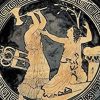Analysis
The images of this ode foreshadow the death of Agamemnon and the sorrows that will continue to afflict the House of Atreus (for example, the description of Zeus casting the net of destruction over Troy also alludes to how Clytaemestra will trap Agamemnon in a net before killing him). The story of the horrors brought down on Troy because of Paris’ sin is meant to parallel the story of the destructive forces brought into action by Agamemnon’s sacrifice of his daughter. The main point of the ode is that retribution comes to all sinners. This universal moral law applies as well to Agamemnon as it does to Priam and the Trojans although only Troy is used as an example. The stasimon begins as a hymn of joy on the downfall of Troy but ends as a tacit condemnation of Agamemnon and a hint that worse things are still in store.
The portion of the ode beginning “The god of war, money changer of dead bodies” is one of the most famous lyrics written by Aeschylus. It is a simple but moving description of the horrors of war. One critic has said of it, “no greater lyric poetry than this has survived from ancient Greece.”

